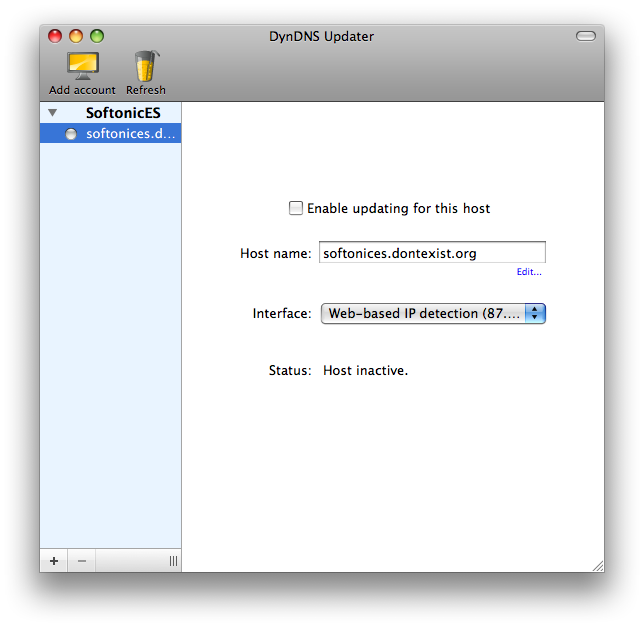Dyndns Updater Download Mac


How to Uninstall Dyn Updater Application/Software on Your Mac. Unlike the software developed for Windows system, most of the applications installed in Mac OS X. Download Dyn Updater for Linux, Mac OS X, or Windows and learn about the features and FAQs about the Dyn Updater. Install the latest version of Dyn Updater for Mac: Free Download - Provides support for updating hosts and more. Download the latest versions of the best Mac apps. This guide will walk you through how to setup the Dynamic Update Client and explain the additional preference settings that are available. You will need to first go to and download the Mac version of the DUC. Click the “Download” button. After the file has downloaded, go to the top right.
Thank you for downloading DynDNS Updater for Mac from our software portal DynDNS Updater is distributed free of charge. The download was scanned for viruses by our system. We also recommend you check the files before installation. The package you are about to download is authentic and was not repacked or modified in any way by us. The download version of DynDNS Updater for Mac is 3.0. DynDNS Updater antivirus report This download is virus-free.
This file was last analysed by Free Download Manager Lib 1101 days ago.
Download Driver Sis 661 Windows 7 there. You’re on the road, it’s the night before your big presentation, and after a long day of travel you fire up your Mac to do a last-minute check on your slides. That’s when you realize that you forgot to bring them with you—that the presentation your business’s future depends on is sitting on your Mac at home, hundreds of miles away. With a little forethought and preparation, this wouldn’t be a problem.
You’d just log in to your home computer and retrieve the file via FTP. But you can’t log in to a remote computer if you don’t have its Internet Protocol (IP) address. And if you’re like most of us, your Internet service provider assigns your computer a dynamic IP address that changes all the time. Fortunately, there is a workaround, using an Internet technology called dynamic DNS. What is dynamic DNS?
DNS, or Domain Name System, translates addresses like www.macworld.com into numeric IP addresses that Net routers can understand. When you type www.macworld.com in your Web browser, your Mac asks your ISP’s DNS servers for the corresponding IP address, which it then uses to take you to the Web site you want. Trouble is, if it's your own computer you're trying to reach, that IP address changes all the time (unless you've arranged for a static IP address). Dynamic DNS providers get around that problem by assigning your computer a plain-English name that stays the same even when your IP address changes. To connect to your home Mac, you just have to remember that name. Getting started Several companies offer dynamic DNS services.
(See.) For this column, I’ll use DynDNS as an example, but the instructions are similar for other providers. The first thing you need to do is set up an account.
With DynDNS, that means going to and clicking on Create Account to get started with a free account. Once you’ve created an account, log in with your new user name and password, click on My Services, and then click on Add Hostname to the right of the Host Services list in the middle. Now it’s time to select your Mac’s plain-English Net address.
That address has two parts: The left-most part, which comes before a period preceding the domain name (the dmoren in dmoren.dyndns.org), is called the host name. That can be anything you want, as long as someone else hasn’t registered it already. Fill in the name you want and then open the drop-down menu next to the host-name field.
To enable a dynamically changing address, you pair a domain name provided by DynDNS with a host name you create.This menu is where you choose the second part of your address, the domain name, which is everything after the first period. Dynamic DNS offers an extensive list of domain names, ranging from the bland ( dyndns.org) to the quirky ( boldlygoingnowhere.org) to the oddly specific ( is-a-chef.net). Your choice here is largely a matter of taste (unless you’re going to be hosting a business Web site on your home Mac, in which case it’s also a question of marketing); the important thing is to choose a name you’ll remember. The next field down, IP Address, needs to be filled in with your current IP address.